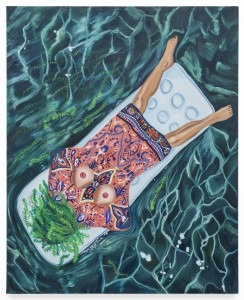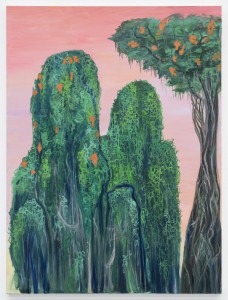My current body of work represents figures in various states of being covered with exposed body parts peeking through plants and fabrics. The covering examines the dichotomy between invisibility and hyper-visibility and serves as protection and as a shield to the figures. In some, fabrics cover the figures, harkening back to the Victorian photography genre “invisible mothers” and in others, invasive plant species. Invasive plant species are used to discuss women reclaiming their own agency and body just as these plants reclaim the earth. These plants serve as a signifier of reclaiming subjectivity and ownership. With exposed body parts peeking through the plants and fabrics, I play with the idea of the invisible becoming seen, hidden in plain sight.

The photography genre of invisible mothers was prevalent during the Victorian era when there was a need for long camera exposure times. These images have their own poetry: when are women to be looked at and when are they to be obscured? In order to capture photographs of children, the mothers would need to camouflage themselves to hold the child still. They would be obscured by fabrics that resembled the background or they were covered to look like pieces of furniture. Mothers were covered by blankets, rugs, wallpaper, and sometimes placed in awkward areas of the photo to later be cropped out. These women seemed to exist in an in-between space of invisibility and hyper-visibility. I had to ask: Do all women grow up to be invisible? I changed from painting portraits of people whom I had connections with, to painting women without clear identities existing in undefined spaces.

Nature is a common thread throughout my pieces. The solitary figures are hidden in nature, covered by nature, and sometimes covered by fabrics with nature-inspired designs on them. My choice of plant species is from the local Florida flora including invasive species that inhabit the southern United States. For example, kudzu-the “plant that ate the south”-is the most invasive plant in the Southeast of the United States and grows up to a foot a day. It finds a host tree and creeps up it from all sides, all while feeding on the tree, until eventually, it has entirely covered every inch, every leaf, starving the host tree of light and water in its quest for survival. Along with kudzu, I also work with hydrilla and bamboo because of their invasive, aggressive, and uncontrollable behavior. They are poetically similar to the way that the pandemic completely changed the landscape of our lives. I explore the tradition of tying nature to femininity in art; however, I chose to cover my figures in these invasive plant species to signify them protecting and reclaiming their space, similar to the covered women who exist in paintings despite attempts to make them invisible with fabrics and plants.

Currently my work is moving away from the figure within landscape, and now I’m exploring bodily still lifes. I’ll post more soon!



